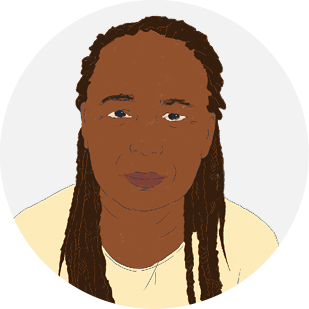I will work until they throw dirt in my face if I'm capable.
Where we are
Many older people in the United States struggle to understand when or if they can retire. Difficult decisions and sometimes overwhelming complexities accessing retirement programs make for a stressful transition.
Nearly nine out of ten people aged 65 and older receive Social Security retirement benefits, and Medicare covers nearly 64 million people1. Yet—irrespective of income, education level, and race—navigating the process to claim retirement benefits and enroll in Medicare can be time-consuming, confusing, and complex for new enrollees. For example, people may have to share the same information with several government agencies, while navigating differing age-based eligibility thresholds. If the process feels too overwhelming, individuals may miss out on critical supports for which they are eligible, including financial, housing, and nutrition.

Our approach
To start, we listened to people’s stories.
The Life Experience research team spoke with people nationwide about this moment in their lives and where the government process could have been simpler and more helpful. The listening sessions captured honest conversations about peoples' experiences, candid feedback on what could have worked better, and what really made a difference for them. Their stories have been combined and are represented here through illustrations. The quotes are real, but names have been changed.












Throughout the three-month discovery, the team collaborated across four agencies to perform primary and secondary research analysis around the approaching retirement experience. Of the 42 seniors who participated in listening sessions, diverse representation included 14 couples, 25 women, 18 persons of color, 7 widowed, and 7 high school educated.
The team spoke with:
- 42 seniors
- 40 Medicare and Social Security experts
Discovery insights
Framing for collective thinking about customer pain points
How might we improve access to tools and knowledge that help remove barriers to financially preparing for retirement, especially for people in underserved communities?
How might we ease the transition to retirement by streamlining the user experience and better connecting people to accurate support to aid their decision making?
How might we provide equitable access to available resources to help seniors recover from employment setbacks and to increase financial security by ensuring individuals understand the benefits and programs available to them?Design Phase
Designing customer-centered solutions
View progress on our milestonesIn the 2023 design phase, the portfolio team started two pilot projects:
- Increasing access to decision-making support for older adults designed and tested two concepts to improve the customer experience: an integrated Federal resource guide and a community of practice for local community-based organizations.
- Streamlining Medicare-only enrollment began with an extended scoping process to further target specific enrollment process pain points for improvement and better integration. The collaborating agencies started the project; however, it is currently paused due to SSA’s resource and capacity concerns.
The project will facilitate a community stakeholder-centered design process to build and test an information and outreach model to help older adults make informed retirement and healthcare decisions through connections to trusted community-based resources.
Project objectives
The project aims to increase the accessibility and availability of holistic resources at existing touchpoints (such as community-based organizations); raise awareness about local resources; and reduce the burden on older adults as they are making retirement and healthcare decisions. As a result, individuals will more easily determine the correct steps for their situations.
December 2023 update
The team led the project through a complete design phase, which included designing two concepts to support older adults, their caregivers, and frontline staff: an integrated Federal resource guide and a community of practice. The team developed the concepts from sketches to prototypes throughout nine co-design sessions with national and community-based organizations and 11 cross-agency workshops. The prototypes create a foundation for agencies to transcend separate functions or departments and collaborate in new ways, which should lead to more systemic and customer-centered interventions.
- The resource guide consolidates information on resources and benefits from seven agencies to help older adults, caregivers, and frontline staff make informed decisions about healthcare, finances, housing, and nutrition. It consists of modules including Federal benefits and services available, rules and considerations for eligibility, how and where to apply, and where to turn for personalized assistance. The project team developed the content collaboratively with input from HHS (both ACL and CMS), CFPB, HUD, SSA, and USDA. The team completed usability testing with six frontline staff and six members of the public.
- The Community of Practice is a community of staff who support older adults to connect with Federal staff who work in senior-focused programs. It will center around learning through engagement, with topics that strengthen Federal understanding of how programs can better connect to on-the-ground needs, and will focus solutions on specific outreach challenges or communities that are hard to reach. The project team created a prototype of the Community of Practice and tested it through a desirability survey.
In FY 2024, the Administration for Community Living (ACL) at HHS will lead the pilot phase for both concepts. ACL will launch digital and translated versions of the resource guide and pilot an in-depth pilot with select community-based-organizations. Additionally, ACL will pilot a year of quarterly Community of Practice sessions, hosted collaboratively by Federal agency partners across Government.
Milestones
Measures of success
Key outcomes:
The project’s success is defined by its ability to reduce customer navigation burden and duplicative processes, connect older adults to streamlined information available across a variety of Federal agencies and programs, and improve the ability of older adults to make informed choices that work for them.
Design phase project measures:
The project focuses on improving the customer experience for individuals who are 65 and eligible for Medicare but are not yet receiving Social Security Retirement benefits. Currently, customers determine their eligibility for Medicare using information primarily from CMS and then navigate to SSA.gov to enroll.
Project objectives
As people approach retirement, they commonly make time-sensitive decisions about Federal retirement benefits and their health coverage. The decision-making process requires that people navigate multiple Federal websites to understand their choices and how to enroll. While some older adults are automatically enrolled in Medicare based on past retirement benefit selections, an increasing number of people enroll through SSA when they turn 65. Interviewed customers expressed difficulty self-navigating across Federal, social sector, and private entity websites; this disjointed network can result in missed benefits, a burdensome user experience, and sometimes monetary penalties.
This iterative, multi-phase project will begin enhancing the customer experience by improving Medicare content and information on SSA.gov and Medicare.gov. Subsequently, the project will further develop improvements to modernize and streamline the Medicare-only application process.
December 2023 update
In early 2023, the team conducted an extended scoping effort to identify near-term and longer-term improvements that could enhance the customer experience enrolling in Medicare-only at age 65. The team began by improving content and page design on SSA.gov and Medicare.gov. They also explored options for more process design improvements as individuals navigate the two websites and enrollment steps.
The team completed secondary research to understand when and how customers enroll in Medicare and the pain points that some people experience. The team conducted stakeholder interviews with staff from SSA operations and CMS Medicare.gov; they also shadowed telephone appointments for customers enrolling in Medicare through SSA. The team also reviewed existing reports that address improving customer experiences.
After this extended scoping phase, the team paused the effort for now due to SSA’s concerns with its resources and capacity to continue the work in the near term. The team’s work to date—including on customer insights, potential solutions to modernize and streamline the Medicare-only application process, and the in-depth confirmatory research needed to support those solutions—will inform future efforts. Additional information is provided below.
Milestones
Measures of success
Key outcomes:
This project aims to see a measurable reduction in the time spent between customers’ decision to begin the Medicare enrollment process and when the coverage begins. Project success depends on its ability to reduce customer navigation burden, minimize duplication, and effectively communicate the steps to enroll in Medicare.
Project Documentation
- Project Charter
- Project One-Sheet
- Design Project Summary: Increasing Access to Decision-Making Support for Older Adults
- Design Project Summary: Streamlining Medicare-Only Enrollment
- Customer Journey Map & Stories
- Information collection approved under OMB Control #3206-0276
- Life Experience Initiative Summary
- Executive Order 14058
- President’s Management Agenda
Project Outputs
Agency collaborators
- General Services Administration (GSA)
- Department of Labor (DOL)
- Department of Housing and Urban Development (HUD)
- Department of Agriculture (USDA)
- Office of Management and Budget (OMB)
- Department of Health & Human Services (HHS)
- U.S. Department of the Treasury (Treasury)
- Social Security Administration (SSA)
- Consumer Finance Protection Bureau (CFPB)
